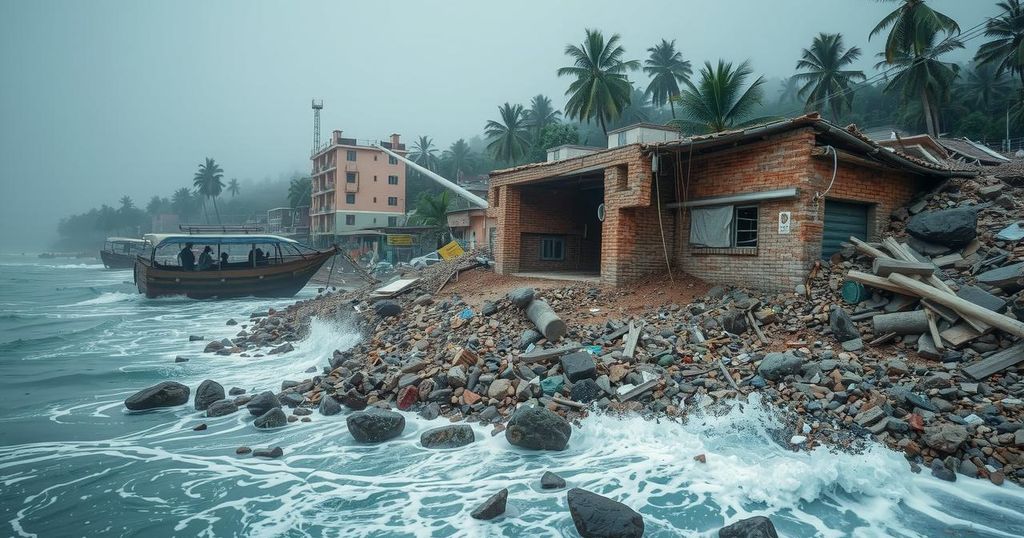Two Decades Later: The Lingering Impact of the 2004 Tsunami on Nagapattinam

Two decades after the devastating 2004 tsunami, survivors like Yusuf Ansari share their traumatic memories of the event that claimed roughly 230,000 lives across a dozen countries, including 10,749 in India. Local governments and organizations have undertaken rehabilitation efforts, yet emotional and infrastructural challenges persist. Commemorative activities planned by fishermen reflect ongoing grief and remembrance.
NAGAPATTINAM, India (AP) — On a fateful morning two decades ago, a young boy named Yusuf Ansari was enjoying a game of cricket near the ocean when a 9.1 magnitude earthquake struck off the coast of Sumatra, triggering a devastating tsunami that swept across several countries, including India. “Out of nowhere, we saw a boat tossed by the waves, followed by a massive rush of dark water and a big wave of water. It all happened so fast,” recalled Ansari, now a 32-year-old motor rickshaw driver. The disaster, which occurred on December 26, 2004, resulted in the loss of approximately 230,000 lives in a dozen countries. To honor the memory of those lost, local fishermen plan to observe a minute of silence next Thursday, along with other commemorative activities including offering flowers and pouring milk into the sea.
Among the affected was Jaya, who described the moment when her life changed forever. While her husband was fishing, she watched in horror as dark waters churned and waves surged. “The boys were playing near the shore, and I could see people gathering, staring at the waves. At first, no one understood what was happening,” she imparted. The aftermath of the tsunami left 10,749 individuals dead in India, with Tamil Nadu alone suffering nearly 7,000 fatalities.
In response to the catastrophic event, the Tamil Nadu government, aided by the Asian Development Bank and the World Bank, embarked on extensive rehabilitation efforts. Residential areas have been rebuilt with enhanced infrastructure, including electricity, sanitation facilities, and reliable water supply. Furthermore, a tsunami memorial tower was erected in Velankanni town, approximately 320 kilometers south of Chennai, to honor those who perished. However, challenges remain, particularly regarding coastal protection. Fisherman Kuppi Ratnam lamented, “The stones don’t hold up any more, and the sand keeps washing away. We’ve asked the government to fix it, but the problem remains.”
While many families received housing support from the government, the solution did not extend universally; some individuals lacked the resources to rebuild, while others struggled to revisit areas burdened by trauma. As the community reflects on the devastation caused by nature’s wrath, the emotional and physical scars of that day continue to resonate across generations.
The tsunami of December 26, 2004, was among the deadliest natural disasters in recorded history, resulting from a massive undersea earthquake off the coast of Sumatra, Indonesia. The repercussions were felt across a vast geographical area, affecting countries as far as East Africa. In India, the coastal regions, particularly Tamil Nadu, bore the brunt of the destruction, with thousands of lives lost and communities torn apart. Government and international organizations responded with long-term recovery efforts aimed at rebuilding infrastructure and resettling displaced populations. Despite these advancements, enduring challenges persist as local communities grapple with the memories and consequences of this catastrophic event.
The aftermath of the 2004 tsunami serves as a poignant reminder of the fragility of life and the persistent challenges faced by communities affected by natural calamities. Initiatives for rebuilding and rehabilitation have made significant strides but have not resolved all issues faced by residents, many of whom continue to confront emotional scars and infrastructural vulnerabilities. Memorial observances not only honor the victims but also resonate with a call for sustainable solutions and support for those still affected.
Original Source: www.seattletimes.com








